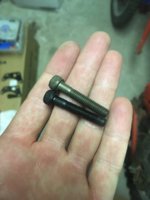AndersJ
XS650 Addict
Nice work Jim! I was inspired by those videos you posted, and since I’ve always wanted to try electroplating I just went ahead and made a set up. Attached is a photo of a socket head screw that was originally black oxide coated, and is now nickel plated. 45 minute bath. My solution is very green at this point. Thinking about plating the hardware and engine brackets (at least) for a Honda XR75 project I’m working on.




